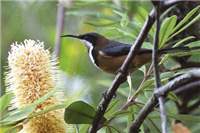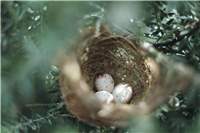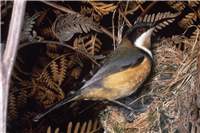Family
Meliphagidae
Genus
Acanthorhynchus
Species
tenuirostris
Threats/Control Methods - Regional
Ideal native species like epacrids are declining across Australia due to land clearing, fungal diseases and habitat destruction. The honeyeaters themselves have the ability to add to this destruction by spreading weeds when they are forced to feed from introduced weed species due to a low availability of flowering natives. This species is prone to attacks from feral Cats (Felis catus), especially in the summer months when bird families are at their unprotected and often exposed nests.
Threats/Control Methods - Local
Areas without native shrubbery and ground cover within the suburbs are limiting the available habitat for this species.
Local/Urban Actions
Cat owners should consider de-sexing their pets and providing a stimulating indoor or enclosed environment for them to enjoy, without the opportunity to hunt. Gardeners considering new plants for the garden are encouraged to plant native species such as grevilleas and to remove any weed species.
Common Names
Eastern Spinebill, Cobbler's Awl, Spine-billed Honeyeater
Distinguishing Features
This is the smallest of all the honeyeaters, at 14-16cm in size. Adults have a bright red eye and a fine, strongly down-curved bill. The crown and sides of the head are black, a patch on the throat and very back of the head is chestnut, while the rest of the throat and chest is white. The wings and back are grey and the underbelly is peach coloured. Young birds are grey to brown and do not have the same bright red eyes.
Survey Techniques
Call and visual identification.
Species Call
A sharp, high-pitched 'chip-chip-chip-chip' in long sequences.
Similar Species
The Crescent Honeyeater (Phylidonyris pyrrhoptera ) has a similar size, shape, red eye and down-curved bill, however it is darker grey with yellow colouring and is far less common in the Canberra region.
Distribution
The Eastern Spinebill is found in highest numbers along the east coast hinterland and mountainous areas from Brisbane to TAS.
Country of Origin
Australia
Conservation (Pet/Pest) Status - Regional
This species has become very well adapted to suburban living and readily feeds on the nectars found in most home gardens, with numbers increasing gradually over the past 20 years (COG).
Conservation (Pet/Pest) Status - National
Secure, not listed under the EPBC Act 1999.
LSCCES Population
The Eastern Spinebill was found in particularly high numbers at the ANBG. Others were found at CSIRO and some were detected in Civic West, ANU and Turner.
Associated vegetation community
This species prefers forest and woodland areas with thick, shrubby understorey.
Limiting Resources
The Eastern Spinebill requires an abundance of bushy nectar-bearing vegetation, ideally native vegetation.
Breeding
Nesting activities take place from late August to late September, with the female building the small cup of twigs and grasses in low tree or shrub branches. She will then lay two eggs, requiring two weeks incubation. Dependant young are feed by both parents in the nest for two weeks and these young can be seen in the Canberra area in all of the warmer months, from November to April.
Behaviour
This is a very active and approachable bird, easily detected as it feeds from the shrub layer of native species. The highest numbers of birds are seen in the winter, as birds from higher in the mountains move down to the warmth of the Canberra region.
Functional Group
Food Species
The Eastern Spinebill feeds on insects and nectar while perched or while hovering. Nectar is obtained from a wide array of flowers, including grevilleas, but its beak is particularly well-suited to extracting nectar from tubular flowers such as epacrids.
Predators
Cats (Felis catus) have been known to attack juvenile honeyeaters while in the nest.
Interesting Fact
The Eastern Spinebill hovers like a hummingbird while drinking nectar.
References - (reader suitability of references, P=Primary teachers, S=Secondary students, T=Tertiary students and researchers)
Books:Freudenberger, D. 2001. Bush for the birds: Biodiversity enhancement guidelines for the Saltshaker Project, Boorowa, NSW. Consultancy report to Greening Australia ACT and SE NSW Inc. CSIRO Sustainable Ecosystems. Canberra. S, T
Morcomber, M. 2000. Field guide to Australian Birds. Steve Parish Publishing, Archerfield. P, S, T
Schodde, R. and Tideman, S. (eds) 1990. Reader's Digest Complete Book of Australian Birds (2nd Edition). Reader's Digest Services Pty Ltd. Sydney. P, S, T
Veerman, P. 2003. Canberra Birds: A report on the first 21 years of the garden bird survey. Philip Veerman and Canberra Ornithologists Group. Canberra. S, T
Internet: Birds in Backyards 2006. [online]. Available at:http://www.birdsinbackyards.net P, S, T
Canberra Ornithological Group (COG). 2004. Birds of Canberra Gardens. COG and the ACT Department of Urban Services. [online]. Available at:http://garden.canberrabirds.org.au/ P, S, T
Online Publications:Department of the Environment and Water Resources. 2007. Tasmanian Forest Epacrids. Australian Government. [online]. Available at:http://www.environment.gov.au/biodiversity/threatened/publications/tas-epacrids.html P, S, T
Nix, H. and Cunningham, R. 2006. Birds of the Lower Sullivans Creek Catchment, Canberra ACT. Prepared for the Life in the Suburbs project using data from the Lower Sullivans Creek Catchment Ecological Survey (LSCCES). Australian National University. Canberra. [online]. Available at: http://www.lifeinthesuburbs.com.au/category.php?id=65 S, T
Olsen, P. et al. 2005. The State of Australia's Birds 2006: Invasive Species. Supplement to Wingspan 16:4. Birds Australia. [online]. Available at: http://www.birdsaustralia.com.au/soab/SOAB2006.pdf S, T



 Top
Top Top
Top